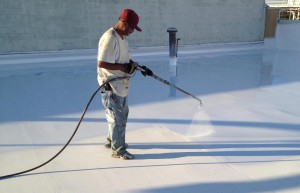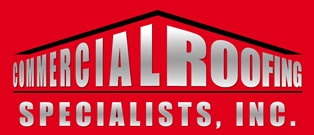CAN A SPRAY APPLIED COATING HELP YOUR ROOFING SITUATION?

Spray applied coatings are a more recent development in the roofing world. They don’t quite have the reputation or clout of many other roofing materials to be a front runner in the industry just yet, but the performance of these products in the market so far has been impressive. Spray applied coatings are just one of the many different flat roof replacement options available to you today. You can learn more about other options by reading our blog post on flat roof replacement options. There are many different coatings out there and each of them has different strengths and weaknesses depending on what they were designed for. Three of the most common coatings are silicone, acrylic and aluminum.
Advantages of Spray Applied Coatings
The most significant advantage of any spray applied coating is its ease of application. Simply stand on the roof with a pump and a sprayer and you can apply the coating. Most coatings adhere directly to most substrates without a primer, so that is another step you don’t need to worry about.
Another huge advantage of the system is that it is seamless. Once applied, the coating can bond to the roof surface and to itself. This forms a complete membrane on the roof that water can only penetrate if the system is installed incorrectly. The adhesion and cohesion properties of spray applied coatings allow it to bond to the roof even around difficult and awkward protrusions.
The next significant advantage of spray applied coatings is their reflective properties. Once they have cured, most coatings reflect the sun’s rays back into the atmosphere and help to keep both the roof surface and the building interior cool.
Another advantage to consider is ease of repair. Should a crack or leak develop in the coating, it can typically be sealed with caulk and repaired in about 15 minutes once located. Bi-annual inspections can help you keep track of areas that are damaged or appear to be at risk. Once you identify the problem, it can be fixed and the roof is once again water tight.
Disadvantages of Spray Applied Coatings
The installation process is tedious. While it is simple and often fast, it takes some small movements and precision that is absent from other roofing materials. This means you need quality contractors that stay focused the entire time, or something may get missed.
Another disadvantage of spray applied coatings is the visual aspect. When first applied, these roofing systems are beautiful. Crisp, clean, and very shiny. However, after not much time in the weather, they begin to grab dirt and leaves and other foreign substances. Spray applied coatings often remain sticky for some time after installation, and that means they hold onto everything, including dirt. While they can be easily cleaned with a power washer, they will get dirty again. This is perhaps the greatest weakness of spray applied coatings; they don’t look as good as some of the others.
Conclusion
Spray applied coatings are one of the best materials to put on a flat roof today. They require no tear-off, and their disadvantages are considered minor by most people. They aren’t perfect, but they lack a lot of the problems that come with many other roofing systems. If you are considering spray-applied coating, consult a professional to figure out which is best for your roof and your climate.
